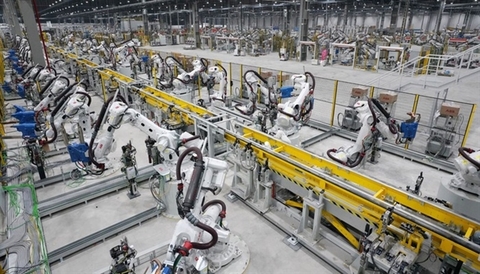
A corner of VinFast Automobile Manufacturing Plant in the northern city of Hai Phong. It is expected to promote the country's automobile industry in the future. — Photo Vingroup
The industrial sector must provide motivation for economic growth, creating breakthroughs in improving productivity, quality, competitiveness and domestic added value of industrial products.
The statement was released by Minister of Industry and Trade Tran Tuan Anh at a meeting to review results and set tasks for the future with the leaders of the Department of Industry in Ha Noi this week.
Anh urged the department to support the protection and expansion of the domestic market, maximising export advantages from signed free trade agreements for key industrial products.
According to a department report, the industrialisation process has greatly contributed to the country’s socio-economic development. However, there are still many problems impacting the value of the domestic industry, including Viet Nam’s production efficiency in terms of added value and exports. The main forces behind restructuring and value are still FDI enterprises, not domestic ones, and Viet Nam’s export of goods still heavily depends on imported materials.
Taking about the automobile industry, director of the Industry Department Truong Thanh Hoai said the automobile industry is currently participating in the low segment of the manufacturing chain, heavily depending on global automobile corporations’ manufacturing assignment.
“The industry has not mastered core technologies such as engines, control systems and transmission systems and has not yet established a system of large-scale suppliers of raw materials and components,” Hoai said.
Hoai said car selling prices are still high compared to other countries in the region. The localisation rate (local part supply) for cars with nine seats and fewer is still lower than the set target, and much lower than other countries in the region.
Meanwhile, the products, which have been localised, have very low technology content such as tyres, seats, mirrors, glass, wires, batteries and plastic products, he added.
For the automotive industry, Minister Anh asked the department to continue working and discussing solutions on the basis of enterprises’ proposals to create momentum for the automobile industry’s development, including tariff reductions and market size expansion for the industry.
“It is necessary to continue to revise the Decree 116 [regulating the conditions for production, assembly, import and business of automobile warranty and maintenance services, issued on October 17] in the direction of protecting domestic production but it must be still suitable to the integration process,” Anh said.
Anh pointed out that there must be investment policies and a long-term industrial strategy, especially specific orientations in the value chains for the automobile industry or textile industry.
"We have a draft circular regulating products and goods of Viet Nam and products and goods made in Viet Nam, which is a tool creating links between the industry and supporting industries. It will contribute to the country's overall economic development,” Anh said.
According to the General Statistics Office, Viet Nam’s index of industrial production (IIP) rose 9.4 per cent year-on-year in the first seven months of this year.
The processing and manufacturing sector, which accounts for nearly 80 per cent of domestic industrial production, led the growth of the whole sector with a significant IIP increase of 10.7 per cent. — VNS